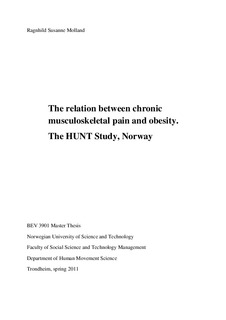| dc.description.abstract | Background: General obesity is a risk factor for fibromyalgia (FM), especially in physically inactive women, while abdominal obesity is a recognized risk factor for, and a feature in several metabolic diseases. Women with FM have shown higher prevalence of metabolic syndrome compared to healthy women. However, whether FM and chronic musculoskeletal pain are associated with abdominal obesity, independent of concurrent general obesity, is unclear.
Objective: To examine the association between FM and severity of chronic musculoskeletal pain and, 1) general obesity (i.e., peripheral or overall body fat distribution) and, 2) abdominal obesity (i.e., central body fat distribution). In addition, the impact of physical exercise on these associations was investigated in supplementary analyses.
Methods: A cross-sectional study was conducted on levels of Body Mass Index (BMI) and measures of abdominal fat layers (i.e., Waist Circumference [WC], Waist-to-Hip ratio [WHR], and Waist-to-Height ratio [WHtR]) in relation to the prevalence of FM in a large, unselected female population. First, healthy women and women with diabetes mellitus (DIA) and/or glucose level (GL) ≥11.1 mmol/l were used as references (n=28,788). Second, healthy women and women with localized chronic musculoskeletal pain were used as references (n=21,752). In analyses of influence of physical exercise, women with physical impairments were excluded (n=18,988).
Results: BMI and measures of abdominal fat layers showed positive associations to the prevalence of FM, DIA/GL ≥11.1 mmol/l, and FM with DIA/GL ≥11.1 mmol/l (P for trend <0.001), and dose-response relations to severity of chronic musculoskeletal pain (P for trend <0.001). Measures of abdominal fat layers were highly correlated with BMI in all subgroups. Women who reported highest exercise level had lowest BMI and measures of abdominal fat layers.
Conclusion: Both abdominal obesity (indicated by WC, WHR, and WHtR) and general obesity (indicated by BMI) showed a strong dose-response relation to severity of chronic musculoskeletal pain and FM. Physical exercise moderated these relations. Measures of abdominal fat layers were highly correlated with BMI, indicating that central body fat accumulation in women with FM and chronic musculoskeletal pain reflects concurrent overall body fat accumulation. | nb_NO |
